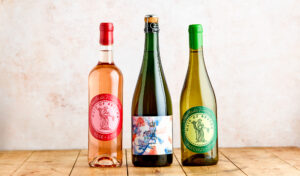
Durslade Vineyard: Cultivating grapes at our vineyard
18 August 2023 |
Just five minutes down the road from Roth Bar & Grill is our vineyard. Durslade Vineyard sits within our estate on a gentle south-eastern slope made up of clay and limestone. It’s located next to the River Brue, opposite the site of an ancient Roman vine terrace.
We have Pinot Noir, Chardonnay, Pinot Meunier and Bacchus grape varieties which once harvested are pressed, fermented and bottled at Bagborough Winery, just five miles away, creating a sparkling rosé, still rosé and Bacchus white wine.

Our grapes flourish in the vineyard through a traditional approach, emphasising quality over quantity through low-density planting. The vines are planted in rows from south to north to maximise their sun exposure. To protect the vineyard, we have planted hundreds of trees and extended hedgerows, as they are natural buffers. This also provides habitats for the local wildlife. We work with minimal intervention while still monitoring the soil and vine health.
The to-do list at Durslade vineyard is constant, involving the care of over 4000 vines throughout the seasons. Below, we talk you through the various steps involved in producing the delicious grapes that we use to create our Maid of Bruton wines.
Winter
From October to March the vines are dormant, and at the vineyard, we focus on pruning the vines to shape them. Pruning also takes into account the health and productivity of the vines so that the best canes are kept. During pruning, two canes from the previous year are retained – a precaution against potential winter frost damage.
Spring
In April and May, the buds start to grow, and we tie down the canes, wrapping them around the lowest wire and removing the spare cane. During this period where the buds are growing, we also remove the buds from the stem of each vine to ensure bud growth is concentrated around the crown and the fruiting cane. This process is called bud rubbing and ensures that the plant’s energy is focused on the areas where we want them to be productive. We also start on shoot selection, where we prune the vines and choose which to keep depending on the potential grapes on these vines, as after one year they turn into canes.
Summer
In July, the grapes begin to flower, and groups of young grapes begin to form. Leaves from around these young grapes are removed to help maximise sun intake and wind circulation, which improves the taste of the grapes. From July to October, the grapes begin to ripen, and we continue to tuck vine shoots back into the wires.
Harvest
In early October, it’s time to harvest! Our Bacchus grapes are the first to be harvested, as they ripen slightly faster than the other varieties. The grapes are then taken to Bagborough winery, only five miles down the road, to begin the winemaking process. Then the cycle at the vineyard begins again, ready for a new year of growing grapes.
From grapes to glass
The grapes from our vineyard are transported to Bagborough Winery, where they undergo crushing, pressing, and fermentation before being blended to become our collection of English wines: sparkling rosé, still rosé, and Bacchus white wine.
Our sparkling rosé is made from a blend of Pinot Noir, Pinot Meunier, and Chardonnay grapes grown on our estate at Durslade Vineyard. It exhibits a lively nose of abundant berries, fleshy stone fruit, and hints of citrus zest and orange blossom. The bottle features a limited edition label created by British artist Catherine Goodman, co-founder of the Royal Drawing School with King Charles III. Order a glass and take a seat in the sun-filled orangery as you relax with friends or loved ones.
For a light, fresh drink perfect on a summer’s day, choose our rosé, which has a bouquet of strawberries, summer berries, nettles, and stone fruits. Made from a blend of Chardonnay, Pinot Meunier, and Pinot Noir grapes, this English rosé is wonderful to share with friends over a delicious dinner.
Our Bacchus white wine is a fresh-flavoured drink with aromas of zesty lime, grapefruit, nettle, and elderflower. A well-balanced wine with a lasting finish, perfect as an aperitif or paired with our seafood or chicken dishes. The label for our Maid of Bruton Bacchus and still rosé was created by acclaimed illustrator and designer Peter Horridge, who most recently designed the Coronation emblem.
Visit us at Roth Bar & Grill to try our incredible wines, which are perfect as an aperitif or with your meal.